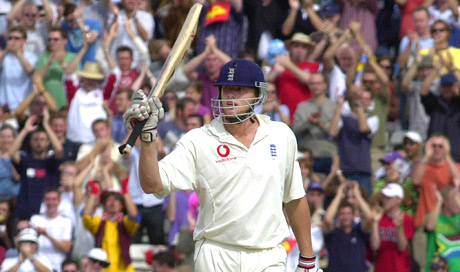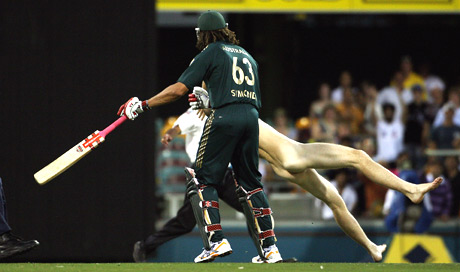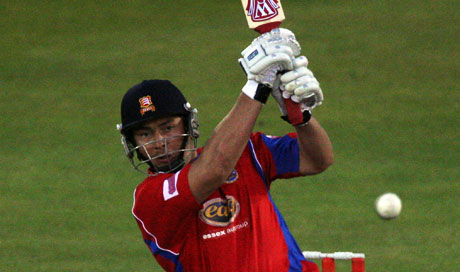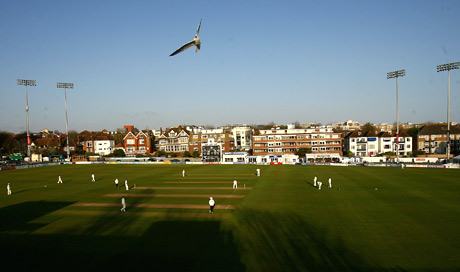
Does Andrew Flintoff represent England’s past or England’s future? We look back at five memories that show just how important he is to England right now…
1. Flintoff’s magic over, England v Australia, 2nd Test, Edgbaston, July 2005
While Andrew Flintoff may not be a prolific wicket-taker, he gets good players out. Here Justin Langer and Ricky Ponting were the victims in an over of resonant brilliance. He began it on a hat-trick (he had cleaned up the Australian first innings with two in two) and ended it with four wickets in nine balls. The ninth ball brought the crucial wicket of Ponting, with a rasping legcutter after Flintoff had bowled a no-ball with the sixth ball of the over.
Following a miserable performance at Lord’s this was the match that confirmed – against the best team in the world – he was a world-class allrounder (68, 3 for 52; 73, 4 for 79). His heroics with the ball followed a brilliant counter-attacking 73 that had single-handedly restored England’s chances after they slumped to 75 for 6 in their second-innings. And all this with a shoulder injury.
At Edgbaston, Flintoff gave his team-mates – and the rest of the country – belief that England could win the Ashes. This over was what England’s attack missed in the last two days at Lord’s – pace, bounce and bags of personality. Things may not have gone according to plan at Headingley, but the precedent is there.
2. 95 at The Oval, England v South Africa, 5th Test, September 2003
If Flintoff’s finest hour was Edgbaston, it was during the South Africa series in 2003 that he finally harnessed an allround talent capable of consistently influencing Test matches.
He had slain 142 in a losing cause at Lord’s, but the defining innings of his summer was to come in the fifth Test at The Oval. In an emotional match of fond farewells (Alec Stewart), welcome backs (Graham Thorpe), and thank god you’ve finally got some runs (Marcus Trescothick), it was Flintoff’s first-innings partnership with Steve Harmison that proved the precursor for England’s successes over the next two years.
That England won by nine wickets when the bookies had offered 40-1 against the victory at the start of the second day says it all. Flintoff and Harmison came together with England’s first innings at 502 for 8, a lead of just 18. Up to that point it had been all Trescothick and Thorpe, their runs rescuing England and ensuring the match looked a certain draw.
Flintoff had other ideas, smashing a quickfire but controlled 95 to give England a 102-run lead and completely change the game’s complexion. One six off Ntini was the highlight, hard, long and straight into the Pavilion. As Wisden put it, “the only thing agricultural about his innings was the assured way he farmed the strike: Harmison’s contribution to a stand of 99 was a level-headed three. For South Africa, the psychological damage of watching ball after ball sail over the rope was as telling as the runs themselves.”
Harmison chose the South African second innings to begin the climb that would lift him to the top of the international rankings within a year – England were on their way to winning the Ashes.
3. Flintoff’s first Test five-for, West Indies v England, 3rd Test, Bridgetown, April 2004
This first five-for of Flintoff’s Test career marks a watershed in his progression as a bowler. Prior to it, Flintoff had taken just 55 wickets in 31 Tests at 45.07. In 37 Tests since, he has 136 at 27.93. With greater experience and confidence he has started to pick up the wickets he had often deserved.
It remains something of a paradox that while Flintoff is feted as England’s best bowler, he has taken just two five-wicket-hauls in 68 Tests. To put that into perspective, using his Ashes stablemates as comparison, Steven Harmison has eight five-fors in 57 Tests, Matthew Hoggard seven in 67, and Simon Jones three in just 18. Even James Anderson, for all his inconsistency, has five in 27 Tests. Admittedly, Flintoff has 10 four wicket hauls to his name but his wicket-taking record remains one of underachievement.
For someone hailed as a returning saviour, a return of one wicket from 40 tight overs at Headingley was modest. Duncan Fletcher wrote in The Guardian: “Andrew Flintoff’s bowling is a concern … We keep hearing about a bowler who’s world-class – he does keep things exceptionally tight – but there is a bit of history in his failure to take big wicket hauls. You must question his thinking about how to get a batter out and his lack of variation.”
In this game, Matthew Hoggard’s second innings hat-trick stole Flintoff’s thunder as England won by eight wickets, but that underlines the strength of an attack that hunted with a formidable pack mentality.
Now, as the leader of a coltish English side (at least in terms of experience), Flintoff has added responsibility. At 30, injury permitting, he could still play another 30 Tests. Can he now learn how to take the regular five-wicket hauls that England need?
4. Bowls Yousuf, Pakistan v England, 1st Test, Multan, November 05
Not a game that England or Flintoff will remember particularly fondly, the Ashes hangover that had begun amid such good humour in Trafalgar Square became a full-blown problem in Multan.
Missing the injured Michael Vaughan and Simon Jones, England contrived to lose by 22 runs after stand-in captain Marcus Trescothick’s 193 had helped them to a first innings lead of 144. Little did we know then that it was the beginning of the end of Trescothick; although even he was powerless as Danish Kaneria and Shoaib Akhtar dismantled England in the second innings.
But one ball from Flintoff, one 87.3mph yorker that was too good for the defensive prod of Mohammad Yousuf, lit up Flintoff’s match. Yousuf would score 337 runs in his remaining four innings in the series. He was Test player of the year a year later. He was no mug.
Against South Africa’s top-heavy top-order in this 2008 series, the yorker could be a vital weapon, and few in England employ it better than Flintoff. Ryan Sidebottom pointed the way when he ripped out Jacques Kallis at Lord’s, but otherwise it has been an underemployed tactic.
Flintoff’s lack of Test wickets could be because he does not bowl straight enough. Flintoff has 198 wickets in 68 Tests, Matthew Hoggard 248 in 67, a difference understandable given Flintoff’s slow start. 142 of Flintoff’s victims have been caught, not far behind Hoggard’s 147. However, 101 of Hoggard’s wickets, or 41%, have come bowled or lbw, as opposed to Flintoff’s 54 (27%). The gap is because Hoggard attacks the stumps. Hoggard may be a different type of bowler to Flintoff, but the message is clear, pitch it up, bowl straight, and you may start getting luckier.
5. Sledging Tino Best, England v West Indies, 1st Test, Lord’s, July 2004
Flintoff brings likeability and charisma to a side that has been dogged with controversy in his absence.
Whatever the individual rights-and-wrongs of jellybean-gate, Grant Elliott-gate and some embarrassing attempts by England players to adopt aggressive body-language, they have cast a shadow over any development under Peter Moores.
This is a famous clip – you’d be hard pushed to find a Flintoff fan who hasn’t heard “mind the windows Tino” – but that doesn’t diminish its value. Flintoff is first hard and to the point with Dwayne Bravo, then talks out Tino Best. Sledging, yes, but with a smile. Hopefully some of his more impressionable his team-mates will take a leaf.
Sam Collins is web editor of www.thewisdencricketer.com







